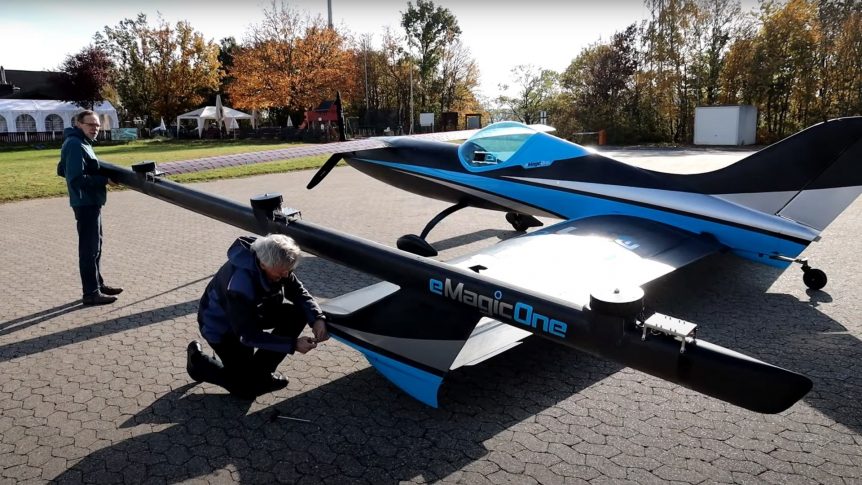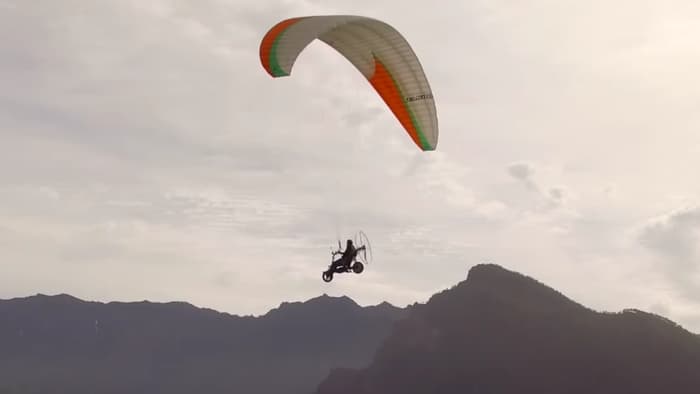Thomas Senkel was an early part of Volocopter, initially called e-Volo. His first efforts resulted in a spider-like creation perched on an exercise ball. It flew, seemed stable, and despite the placement of whirling propeller blades encircling Thomas during his test flights, proved not a hazardous as it looked. Explanatory material accompanying the video declared, “The first manned flight with an electric vertical take-off and landing multicopter (eVTOL) was performed by Volocopter. The flight lasted 90 seconds, after which the pilot Thomas Senkel stated ‘The flight characteristics are good natured. Without any steering input it would just hover there on the spot.’ The flight, which is a Guinness World Record, was performed on October 21st in 2011.” Although he helped develop the e-Volo which transfigured into Volocopter variants, Thomas apparently left the company to strike on his own patent-filled adventures. A Bird in the Canaries He worked on a variety of electric bikes and trikes, with the most aerial being …
Making Like a Canary in the Canaries
Thomas Senkel has gained fame for flying an unlikely-looking multiple rotor helicopter with a Pilates exercise ball landing gear and helping drive through that design to a far more refined Volocopter VC200, which we reported has just become the first certified electric helicopter in Germany Knowing how to get the most out of very little, Senkel skipped the usual “crow-hops” performed by experimental test pilots and instead took a 46-minute ride over La Palma in the Canary Islands with his electric scooter/paraglider combination. The six kilowatt (eight horsepower) hub motor took him up a long hill to the high launch point and the 13.5 kW (18 hp) FlyTech motor launched him into the air for a long flight to the beach below. In either mode, the vehicles uses little energy, doesn’t pollute, and is quiet enough to be allowed in areas where noisy engines would not be permitted. The first prototype of a flyable electric scooter, Skyrider One is a …
EAS VIII: Joby Motors – on Simple and Complex Airframes
JoeBen Bevirt, founder and CEO of Joby Aviation, Joby Motors, and related enterprises, has thought long and hard about the financial costs and lost productivity brought about by the daily automotive commute, a 1.6 hour per day ordeal for many in our urban centers. JoeBen and the Atlantic magazine agree that commuters squander 5.5 billion hours and 2.9 billion gallons of fuel annually, stuck in the fitful despair of slow or unmoving traffic, sharing only frustration and polluted air with their fellow motorists. JoeBen told attendees at the April Electric Aircraft Symposium that several years before, he had the seeming pipe dream of moving people by air in a single-seat, eight-motorm, vertical takeoff and landing, electric commuter aircraft that would take one 100 miles at 100 miles per hour for one dollar. The combination of Greg Cole’s Sparrowhawk and electric power focused too much on efficiency, according to JoeBen, and battery technology had not evolved to allow the practical outcome …
Even in Second Place, VC200 Dominates Awards
Volocopter has evolved from a pilot sitting on a Pilates ball surrounded by multiple model airplane motors to the VC200 – the first Volocopter to carry two people, according to parent company e-volo. As recipient of a 2 million euros grant from the federal ministry of economics and technology, e-volo has worked with a research and industry syndicate to craft the VC200. A sleeker, more finished-looking project than the original flight vehicle, the VC200 held pride of place 15 meters above the crowd attending the “GreenTec Awards” in Berlin, Europe’s largest environmental and economic prize. Completed just in time for the event, and assembled in the auditorium where it received its award, the first prototype of the VC200 was an ever-present reminder of its green credentials. Although the little “David” company earned a second place award, with “Goliath” Airbus taking top honors, “We are proud that we are placed tightly behind a global player such as Airbus,” said e-volo-CEO Alexander …
It’s Official, It’s a Volocopter Video
Thomas Senkel of the German firm e-volo sends this video, the official promotional video for these multi-rotor vertical takeoff and landing aircraft at AirVenture 2012. Better yet, the team will have at least their prototype machine on hand and many displays of future developments. Note the modular structure of these vehicles at the end of the video. Innovation Hangar Alpha will house the VC2 Volocopter, successor to the VC1 and improved in many ways, including three pilates balls for bouncing your landing on. The VC1 was the first “purely electrically powered, vertical take-off and landing (VTOL) aircraft and flew last October. At least the pilot is under the spinning rotors on this version. Seriously, the designs represent a clever and elegant design concept, which embodies ease of control and simplicity of operation. The software which enables smooth flight and nuanced control has to be a marvel of programming. The VC2 is not only a more sophisticated design, but lighter and …
What Has 16 Motors, a Pilates Ball, and Flies?
Your editor would rest easier at night knowing that the intrepid test pilot of this stalky creation were strapped onto a proper seat with a proper restraint system, but the current impromptu nature of keeping the operator out of the multiple twirling blades has worked – so far. Despite its gangly, random appearance, the E-Volo is not just tossed together. The 16 Hacker motors (editor’s best guess – or they might be budget Asian copies), controllers, and large diameter propellers need to be modulated with great finesse to maintain level flight, and that suggests a sophisticated control system, as designed by Stephan Wolf underlying the design. It must work exceedingly well, since pilot Thomas Senkel reported that, “The flight characteristics are good natured. Without any steering input it would just hover there on the spot”. The 80 kilogram (176 pound) device can “land safely” with 12 motors running, indicating that it might be able to remain aloft with three motors …


